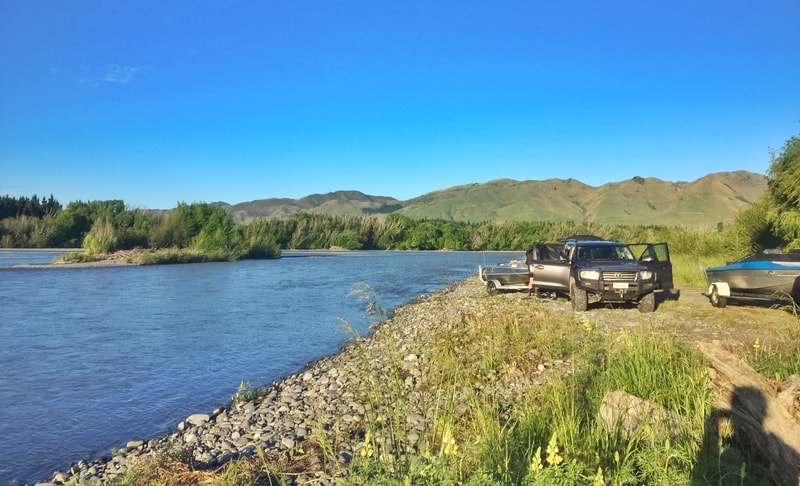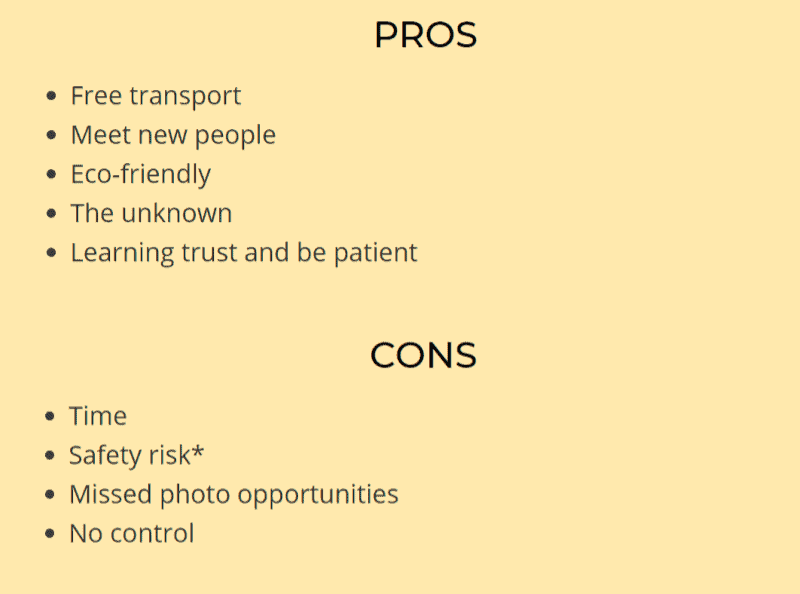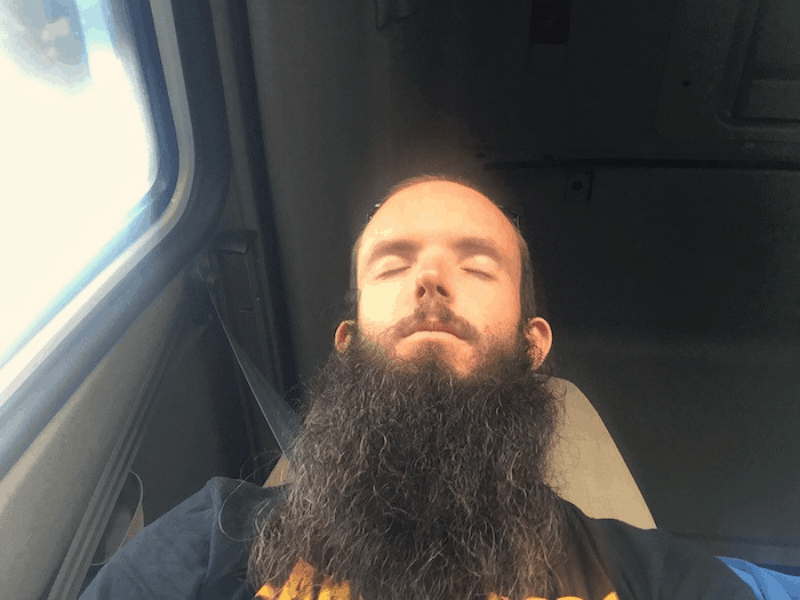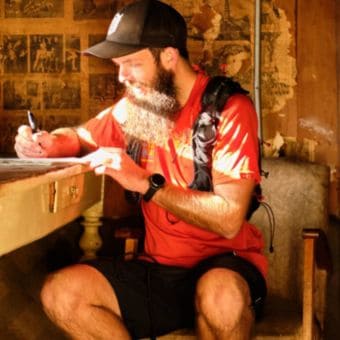Note: I’ve hitchhiked New Zealand throughout the years, including 2020 and 2021. People still pick up hitchhikers 🙂
Planning on hitchhiking in New Zealand?
It’s a great place to do so, especially if you’ve never done so before. In NZ it’s backpackers who are usually hitchhiking New Zealand, but if you spend long enough in the country, you’ll see both tourists and locals hitchhiking.
In this post I’ll help you get started with hitchhiking in NZ. I cover:
- my step-by-step process for hitchhiking in NZ.
- hitchhiking safety and etiquette.
- the background of 10 people who picked me up.
…and a bunch more. But, first things first.
Is hitchhiking legal in New Zealand?
Yes, there’s no law that says you can’t, and no one will give you a hard time for hitching. The only law to keep in mind is that pedestrians aren’t allowed on motorways (there aren’t that many in NZ).
So with that out of the way, let’s get onto the fun part of the post. As someone who has hitchhiked in Europe, North America, Southeast Asia, and Oceania I hope my experience helps you.
TABLE OF CONTENTS
1. Pro’s & Cons
2. Hitchhiking Safety
3. How To Hitchhike
4. Etiquette
5. Stories
1. PRO’S AND CON’S OF HITCHHIKING IN NEW ZEALAND

One pro? Getting to go on random adventures you’d never expect. Read ride three in the stories section for this one.

* In regards to the risks of hitchhiking, there’s a reason I don’t recommend other hitchhike despite loving it myself (well it’s a love-hate relationship)! In short, it’s regarded by most as being dangerous, and while I disagree, you should probably stick with what the majority says. New Zealand hitchhiking culture is great, but that doesn’t mean there isn’t the occasional negative story.
2. HOW TO STAY SAFE WHEN HITCHHIKING
These are tips and tricks on how to stay safe when your hitching in New Zealand (do as I say, not as I do).
TL;DR? Your commonsense and instincts should keep you safe.
- Purchase a sim card with data (I recommend Skinny Mobile for NZ) so you can contact people as needed.
- Let friends and/or family know that you’re going to be hitchhiking, and you’re planned route. If possible, keep in touch with them during the day with updates. This isn’t always possible as parts of NZ will be out of phone reception.
- Hitchhike with someone else ideally. It’s generally considered the safer option and doesn’t affect your chances of getting picked up much.
- When you get a ride, take a photo or memorise the registration plates and send them to someone. Don’t hesitate to let the person picking you up know you’re doing this. If they don’t react kindly to you doing so, don’t accept the ride.
- Have an idea of what roads you need to take and the major towns on the way of your planned route (and if they have accommodation).
- Make sure you can be easily seen on the side of the road and always keep your eyes on the traffic.
- Hitchhiking at night is a no-no.
- Check the weather forecast is and prepare accordingly.
If you want to know the details about the people who might pick you up in New Zealand, I talk about them here.
3. HOW TO HITCHHIKE – STEP BY STEP
If it’s your first time hitchhiking, you’ll likely be nervous, that’s fine…I still get nervous. But, as long as they’re good nerves and you’re confident in your decision, you should be good to go.
This is basically the process I go through before I start to hitchhike on any given day.
- Plan my desired route and check the estimated travel times on Google Maps to various places along the way (remember some of the town names).
- Pin a few locations on Maps.me where I might want to stay if I don’t make it to the final destination (plus the place I want to stay in the final destination).
- Check Hitchwiki to see if the place I’m hitchhiking from/to/through has been written about. If it has been, I’ll usually start hitchhiking from the spot they recommend. If it isn’t on Hitchwiki, I ask people at the hostel or use Google Earth to look for ideal places to hitch from.
- If I need to catch public transport to the hitchhiking spot, figure that out (ideally will walk).
- Check the weather and the sunset time. If it’s raining (or going too), I usually wait to hitch the next day or make other plans.
- In a perfect world I’m awake and planning to leave by 8 am, but this usually ends up being 10 am.
- Make sure I’m wearing a light/bright coloured cat shirt, pants/shorts, and shoes before making my backpack as small as possible. Get the beard is looking sharp.
- Make my way to the hitchhiking spot which is when I make my sign if I’m going to use one (I usually don’t but the majority does).
Once at the destination I take a look at what’s what. What shops there are? Where are the driveways? How fast are the cars going? Are they regularly pulling in anywhere? Are there lots of people around? Are there yellow lines or other places cars can’t stop?
Next, it’s time to find the exact hitchhiking spot. Usually, the ones listed on Hitchwiki are perfect, but if you’re creating your own, find a place where:
- There’s space for the cars to pull over.
- The traffic is ideally going slowly (near traffic lights, at intersections, or next to popular petrol stations/supermarkets”).
- The cars can see you early so they can brake as required.
I’ve now found my hitchhiking spot so it’s time to get a ride. The key is to make a good impression in the few seconds you have.
- I put my backpack and daypack somewhere where it’s visible to drivers but looks as small as possible (some people wear their backpacks).
- Stick my thumb out, facing the traffic (if you walk, walk backward. Carefully). There are different customs worldwide for how to have your hand when hitching, but I’ve always used the traditional thumb approach (the norm for NZ).
- I usually won’t wear headphones, unless it’s somewhere that cars are few and far between.
- I don’t wear a hat or sunglasses as hiding the eyes will hurt my chances (we learn so much by looking into one’s eyes…even at a distance).
- Put on my smile, it feels awkward at first but you’ll adjust. I want to appear friendly as possible (the light coloured shirt plays into this).
- Now that I’m actively trying to get a ride I try to make eye contact with each driver (not awkwardly). It’s all about first impressions!
- If possible I acknowledge each driver with a slight head nod or quick wave but it’s not necessary. The important part is to not get frustrated and lash out and pull the fingers or something silly…sometimes people will change their minds and turn around to come and get you (you’ll start to work out the different hand signals people give as you get more experience).
Now that a car has pulled over with the intention of picking you up (yay):
- 1. Grab my bags and get to the vehicle window as quickly as possible
- 2. Say hey, thanks for stopping and then go from there. They’ll usually ask where I want to go and then I let them know where I want to go. If I want to get to the town they’re going to, jump in (in a perfect world it’s the final destination). Don’t feel as if you need to take every ride though. Sometimes you might be closer to your destination, but there won’t be any good hitchhiking spots at the new place, and other times, you’ll just get a weird feeling – listen to that.
- 3. If I say yes, ask where to put my backpack (usually in the boot). I always keep my small bag with valuables on me.
Once in the car, I introduce myself and say thank you again. From here, it varies, and you’ll need to use your social skills to work out what’s what. Not all people talk, some won’t stop talking, or they can be anywhere in between. I usually check Maps/me every 10-20 minutes if I haven’t been to the region before to check I’m going in the right direction.
Don’t forget to use the safety tips mentioned earlier where appropriate.
4. HITCHHIKING ETIQUETTE

You might feel super tired when you get into the car. Try not to just fall asleep, let the driver know you might close your eyes for a little bit so it’s not awkward.
TL;DR: Don’t be a dickhead to those picking you up or your fellow hitchhikers and you’ll be sweet as (more Kiwi slang here).
- If there’s someone hitchhiking when you arrive at your spot, don’t stand in front of them. It’s normal to have a quick chat, but then walk behind them and try your luck (usually 100 metres is fine if it’s safe). They get first dibs.
- When you get a ride, don’t sit in the backseat unless it’s not possible to sit in the front for whatever reason. It’s not a taxi service.
- If there’s a group of you hitchhiking, don’t get some people to hide nearby so when people pull over they suddenly have a bunch more people they’re expected to carry. Dick move.
- Don’t be an ungrateful brat.
- Don’t hitchhike in places where it’s dangerous for a car to pull over, even if they technically could if they wanted to (commonsense).
5. STORIES FROM HITCHHIKING IN NEW ZEALAND
The following tells you about the 10 people who gave me a ride on a hitchhiking mission I completed in the South Island. To start, I’ll give you the stats based on the 10 people (where there were multiple people in the ca, I have used the driver as the statistic).
- 7 male and 3 female
- 6 cars, 2 campervans, 1 van, and 1 truck
- 8 locals, 2 overseas (the two in the campervans)
- 8 solo drivers
- 0 awkward conversations
And now, onto the stories.
Note: Names have been changed and I’ve kept some details vague to protect identities etc.
RIDE ONE: PICTON TO BLENHEIM
This ride was with a lady (in her 50’s) who had moved from Christchurch to Picton after the 2011 earthquake. When she picked me up she was on her way to the hospital in Blenheim for a check-up as she still wasn’t feeling 100% after being in ICU for a week. I’m not sure how long ago this was…long enough to be fit for driving I guess? An artist of many talents, she’s had a variety of jobs in the art industry and is happy pottering along in life.
RIDE TWO: BLENHEIM TO KAIKOURA
A classic truckie who opened up in the two or so hours we spent together. In his 40’s he was born, raised, and living in Auckland. He wasn’t polite with his word choice towards Auckland (lots of four-letter words) going on to say he’d love to live in Christchurch or the Gold Coast. He was close to moving to Christchurch at one point, but his lady decided it was too far from family.
His family are from the Pacific Islands, and he tries to embrace the Pacific Island culture as much as he can. He met his wife at work, she already had a child from another relationship but he loves him too and calls him his own. His face would light up whenever he mentioned his wife.
He’s been working for the same company for over 20 years (in various roles). Being a truckie is a love-hate thing for him, he loves the driving and scenery but hates how it keeps him away from his family which has proven to take them close to breaking point on a few occasions.
RIDE THREE: KAIKOURA TO KAIAPOI
I was battling to get a ride out of Kaikoura (it didn’t help that I was standing in the wrong place for ages) when Steve pulled over with a jetboat on the back of his 4WD. Steve is from Napier and has lived a pretty crazy life over the years. He has spent 11 of the last 20 overseas (in the USA, Nauru, Australia) with lots of return trips home for work reasons. He worked in a trade of some kind…I was getting confused about this part.
On the day he picked me up he was one car and boat in a convoy of five. They were with a passion for jet boating and were on a lads trip around the South Island for a week on the rivers. They really had no plan having come down from the Napier the previous night.
When they saw a river that was pretty good looking they made an impulse decision to get the boats on the river. I didn’t have a say in the matter. So that’s how I ended up jet boating for a few hours. It wasn’t as extreme as I was thinking, with a few bursts of adrenaline in between casual driving through the Kiwi countryside. Best hitchhiking perk ever.
Steve has a couple of kids who he wished would get off their Xbox and go out on the boat with him and a wife he couldn’t stop talking about. He also had his dog (Jack Russell in the 4WD who loved human touch way too much. I’m not one for dogs AT ALL but hey, a ride is a ride, right?
I thought I might be stuck in Cheviot for the night (which would not have been ideal), but thankfully they decided to drive on to Christchurch. Well nearly. There were 11 of them which meant finding a place at the last minute wasn’t easy. But they found a place in Kaiapoi, 20km north of Christchurch where I left them to it.
RIDE FOUR: CHRISTCHURCH TO ROLLESTON
After taking a Lime Scooter out to the Caltex Station mentioned on hitchwiki on the outskirts of Christchurch, I was waiting a few minutes when a campervan pulled over. Inside were three people from France and one from Taiwan. They had all met in Perth earlier in the year, became friends and were now exploring the South Island after working in Queenstown over the winter. Their campervan was massive, and they were keeping their plans pretty loose with the weather a big factor.
Despite their good intentions, we took a little bit of time to realise we wanted to be on different highways which set me back a couple of hours. Can’t win them all I guess.
RIDE 5: ROLLESTON TO THROUGH ROAD
It took 30 minutes of walking to the place I thought would be the best road to get back on State Highway 73 towards Arthur’s Pass. Turns out that spot was about 2 km from Rolleston Prison so I instantly assumed everyone driving past would think I was escaping prison.
After 45 minutes or so (very few cars in the area) I got picked up by a middle-aged guy from north of Christchurch who spends most of his workday driving around the Canterbury region delivering safety supplies to people living on farms, we even stopped at a house to drop some stuff off. In the back of the van, he had his mountain bike in the van as he likes to go riding somewhere at least once a week. It was only a short ride as he dropped me off at on an intersection closer to the highway I wanted (SH 73). He said he’d come to pick me up again iafter he finished his next job (was gone by then though luckily). Legend!
READ THIS: 26 GREAT REASONS TO LIVE IN NZ
RIDE 6: THROUGHROAD TO DARFIELD
Darfield is along SH 73 so I was finally getting back on track. My ride to Darfield was from a Church Pastor! He’s been a Pastor since 1991 and loves the chance to meet so many people in his role. He was sad as he and the family are moving to the top of the South Island in the coming months and while he’d be a pastor up there, he would miss his friends, who are basically family, at the church. He often gets to Arthurs Pass as all Pastors in the region take turns running a service there each week. Unfortunately, it wasn’t a Sunday!
RIDE 7: DARFIELD TO COALGATE
Another short ride, but this fella in his late 40’s was on his way back to physio and pulled over. He had a lot of fish & chips in the front seat! He was a nice fella, very talkative and his feet were clearly itchy after 8 weeks off work due to an injury. While he seemed to have plenty of excuses for his knee and back injuries (they seemed to be common), I can’t help but think that losing a few of the pounds would help prevent some of them. He dropped me off 15km up the road where there was another road joining the highway that would bring traffic onto my path.
RIDE 8: COALGATE TO ARTHURS PASS
Another lady driver (early 20’s)! She was exhausted having flown from Adelaide to Auckland via Melbourne the previous night. She slept at Auckland Airport (represent!) and flew to Christchurch that morning. She would normally stay at her sisters in Christchurch (where her car was) but had to go home to Greymouth to get her work boots from the West Coast for her next shift the following morning.
She’s a DOC ranger and usually works 8 days on, 4 days off around South Island. She lives with three people she works with so they’re all close. She grew up north of Auckland, so moving to the South Island was a big culture shock as there’s a far high Maori population where she grew up. She was loving it all the same and doesn’t regret dropping out of Uni to pursue being a ranger.
RIDE 9: ARTHURS PASS TO BEALY SPUR TRACK
Jake was someone I would be mates with for sure. He must have driven super quick as the 14km drive to the track went by in a flash. We connected over hiking, rugby, travel, and Denver. I wasn’t quite sure what he did for work as always seemed to be traveling (we were of similar age) and he plans to start walking the Te Araroa Trail in December. Ideally in 100 days or less.
RIDE 10: BEALY SPUR TRACK TO ARTHURS PASS
Two Western European girls in another epic campervan pulled over to pick me up after I finished hiking. They were one month into their two-month kiwi road trip having bought the campervan after arriving in the country. They were loving all the South Island views but at this stage preferred the variety in the North Island. They both had quit their jobs and were so glad they had despite being a bundle of nerves before the trip which was conceived over alcohol.
Tips For Hitchhiking In New Zealand
- It doesn’t really matter where you are in NZ, there’s plenty of space on the roadside space to stand on the outskirts of most towns. And everyone was super friendly.
- Hitchwiki is a great resource for hitchhiking everywhere and while some of the pages aren’t up to date in NZ, I have been using that as my primary source as always.
- In terms of signage, 8/10 times I don’t use a sign. The two times I did were rides nine and ten between Arthur’s Pass and Bealey Spur Track. I got the sign from a hostel friend (the visitor center made the sign for her) and it really would have made no difference.
- I wrote about the best places to hitchhike from in Queenstown here.
A Few Final Thoughts On Hitchhiking in New Zealand
Hitchhiking is funny, I never see hitchhikers on the side of the road in NZ, but there are dozens if not hundreds doing so every day. In my room at the Fat Cod Backpackers in Picton, there were four of us and everyone was hitching. That was pretty random but sums up the hitchhiking culture in New Zealand.
I hope this post helped you prepare for hitchhiking in New Zealand. If you have any questions, drop a comment below, or email me jub@churnewzealand.com.
I would love to hear some NZ hitchhiking stories in the comments below too!

Hey, it’s Jub here. I’m the guy behind Chur New Zealand, helping you have the best time hiking, trekking, walking…whatever you want to call it…in NZ. I’m based in Queenstown and am always out and about exploring trails, old & new. If you have any questions, reach out.
